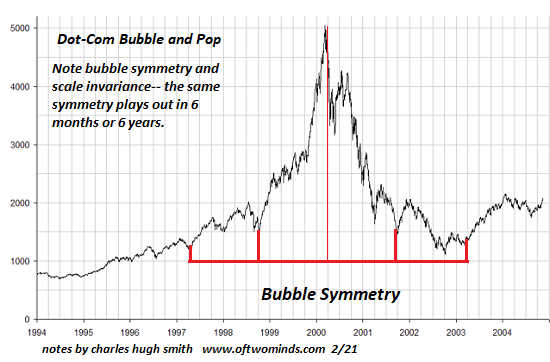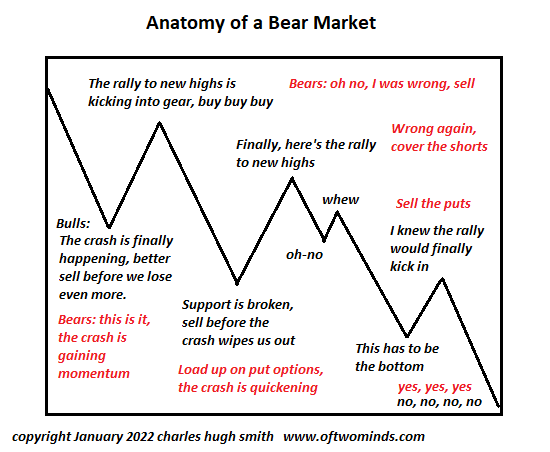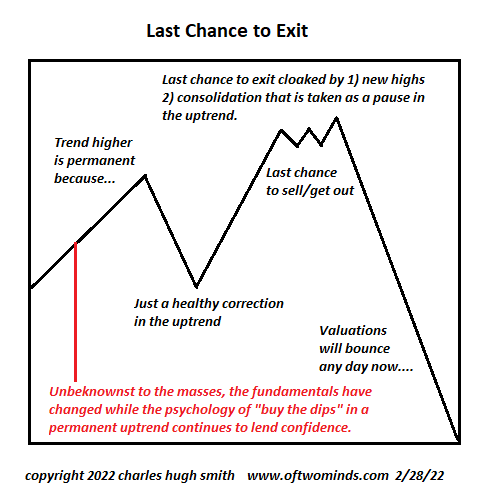
Stocks do not disappear when sold; somebody owns the shares all the method to the bottom. These owners who refuse to sell due to the fact that they have convinced themselves the next dip will be the hoped-for resumption of the bullish pattern are called “bagholders.”
Patterns are challenging. Humans prepare for the present conditions will advance into the future. In economics and financing, we call this extension a “pattern.” Patterns continue till something basic changes and the trend takes a brand-new course.
If property costs, credit, sales, tasks, tax revenues and earnings are all expanding, we call this trend “bullish.”
If the economy and possession prices are contracting, we call this “bearish.”
Individuals are much happier in bullish trends due to the fact that they’re generating income with no effort as the assets they own are increasing in value. They feel wealthier and so they borrow and spend more cash, which enhances the growth.
This self-reinforcing feedback reverses in bearish trends as individuals feel poorer so they borrow and spend less, minimizing need for items and services.
People don’t like feeling poorer so bear trends are not favored. The focus of those in power is to reverse any bear pattern into a bull pattern and extend the bull pattern as long as possible.
But ultimately every bull pattern faces limits. People borrow the optimum their income can support and then they borrow more to wager that properties will continue rising in value.
This flood of money pushes possessions up far beyond their previous value, detaching them from the basics of yields, replacement value, and so on.
As evaluations soar, those who bought the possessions discover that most of their revenues are capital gains from the increasing value, not from earnings. So they buy more assets, anticipating the trend of skyrocketing valuations to continue more or less indefinitely.
However evaluations just increase when need from buyers goes beyond the supply provided by sellers. When the assessment bubble reaches a peak, sellers who decide to take earnings or offer to pay for debt go beyond demand from brand-new buyers and appraisals decline.
This is called “the credit cycle” or “the business cycle” however it’s really a cycle of humanity: when gains are uncomplicated, we wish to increase our gains, so we increase our loaning, leverage and danger to buy more assets.
“Financial investment” becomes pure speculation unmoored from basics. Ultimately evaluations, leverage and financial obligation all reach extremes and so evaluations, financial obligation and leverage all start to contract.
The ecstasy of getting easily richer is replaced by the fear of getting painfully poorer, therefore purchasers turn into sellers.
This becomes a self-reinforcing feedback: as assessments drop, more individuals decide it’s time to sell. Once evaluations decline, owners who bought more stocks with debt are required to sell by margin calls.
What makes this transition intriguing is that people hesitate to let go of a pattern that has actually been great to them. The natural tendency is to believe/ assume/ hope that the asset that is sinking will stop sinking and recuperate its previous bullish trend.
Throughout expansive trends, this “buying the dip”– purchasing more of a property whenever it drops– is rewarded, as every slump is brief and the uptrend soon resumes.
Once the trend has actually reversed, “buying the dip” is no longer rewarded, it is punished, as evaluations continue moving.
Experienced traders search for evidence of this transition due to the fact that they’ve found out the hard method that those who stick on to the concept that the bull pattern is essentially forever because The Powers That Be want it to be permanently end up losing most of their wealth.
Unskilled traders have excellent trouble thinking the uncomplicated gains are ending, as most of traders are still bullish and the financial media is also bullish. It’s simple to find convincing factors to think the bullish growth is merely taking another brief pause.
Money supervisor Jeremy Grantham has actually long studied speculative bubbles. Here is Grantham’s point of view:
“I wrote an article for Fortune released in September 2007 that described 3 “near certainties”: profit margins would boil down, the real estate market would break, and the risk-premium all over the world would broaden, each with serious effects. You can perhaps just have that degree of confidence if you have actually been to the history books as much as we have and looked at every bubble and every bust. We have discovered that there are no exceptions. We are up to 34 finished bubbles. Each and every single one of them has broken all the way back to the trend that existed prior to the bubble forming, which is an extremely tough requirement.”
Grantham sees the present bubble as three simultaneous bubbles overlapping into a super-bubble. The United States stock, bond, and housing markets are all three standard variances from their historical average. Grantham states there have been just four super-bubbles in history: in the United States in 1929, 2000, and 2006, and in Japan in 1989.
It’s intriguing to discuss why the existing super-bubble can’t pop or will not pop, and argue whether this or that will trigger the bubbles to pop. Nobody knows who will be best: those requiring a brand-new bull pattern to new highs or those calling for a crash as the super-bubble finally pops.
I titled this expedition of trend “calm before the storm” since the transition from bullish growth to bearish collapse is ultimately an internal fight within bulls expecting a fast go back to uncomplicated gains.
They have a great numerous factors to want the rally to resume, and couple of reasons to voluntarily accept that keeping the properties that made them a lot cash will now just reduce their wealth.
This yank of war is generally calm. The storm begins when the first “crucial couple of” sellers (4% of owners, if the Pareto Distribution holds) cause 20% of owners to begin offering. This avalanche of selling– the storm– activates behavioral modifications in the 80%.
Stocks don’t disappear when sold; someone owns the shares all the way to the bottom. These owners who decline to sell since they have actually convinced themselves the next dip will be the hoped-for resumption of the bullish pattern are called “bagholders.” Every experienced trader has been a bagholder. The factors and psychology are always the same: we are reluctant to let go of bullish trends and our belief that a long-term modification of trend is not likely.
Possibly the pattern is still bullish and it will never ever be interrupted by the storm of a trend change. But perhaps the trend has actually already altered, and the storm clouds are gathering just over the horizon.



This essay was first published as a weekly Musings Report sent out specifically to subscribers and clients at the $5/month ($54/year) and greater level. Thank you, patrons and customers, for supporting my work and free site.
My brand-new book is now readily available at a 10% discount rate this month: Global Crisis, National Renewal: A (Revolutionary) Grand Method for the United States (Kindle $8.95, print $20)
If you found value in this content, please join me in seeking services by ending up being a $1/month patron of my work via patreon.com.
Current Videos/Podcasts:
Charles Hugh Smith on The Great Awakening Vision (Part II, 36 minutes, with Richard Bonugli)
Charles Hugh Smith on The Excellent Reset Program (Part I, 42 minutes, with Richard Bonugli)
My recent books:
Worldwide Crisis, National Renewal: A (Revolutionary) Grand Strategy for the United States (Kindle $9.95, print $25, audiobook) Check Out Chapter One totally free (PDF).
A Hacker’s Teleology: Sharing the Wealth of Our Diminishing World (Kindle $8.95, print $20, audiobook $17.46) Check out the first section for free (PDF).
Will You Be Richer or Poorer?: Revenue, Power, and AI in a Distressed World
(Kindle $5, print $10, audiobook) Read the first area free of charge (PDF).
Pathfinding our Destiny: Avoiding the Final Fall of Our Democratic Republic ($5 Kindle, $10 print, ( audiobook): Check out the first area totally free (PDF).
The Experiences of the Consulting Philosopher: The Disappearance of Drake $1.29 Kindle, $8.95 print); checked out the first chapters totally free (PDF)
Money and Work Unchained $6.95 Kindle, $15 print) Check out the first area for free
Become a $1/month customer of my work via patreon.com.
NOTE: Contributions/subscriptions are acknowledged in the order received. Your name and e-mail remain confidential and will not be given to any other individual, business or firm.
|
Thank you, Mark A. ($5/month), for your superbly generous promise to this site– I am significantly honored by your assistance and readership. |
Thank you |
, Eliot E. ($5/month), for your splendidly generous pledge to this site– I am considerably honored by your unfaltering support and readership. |

